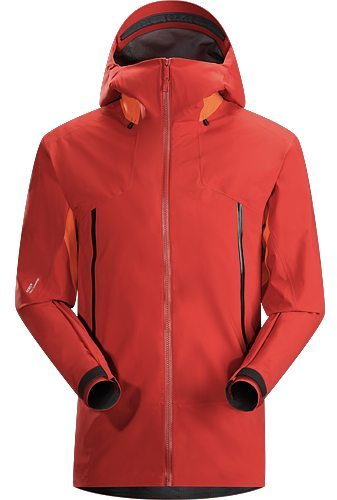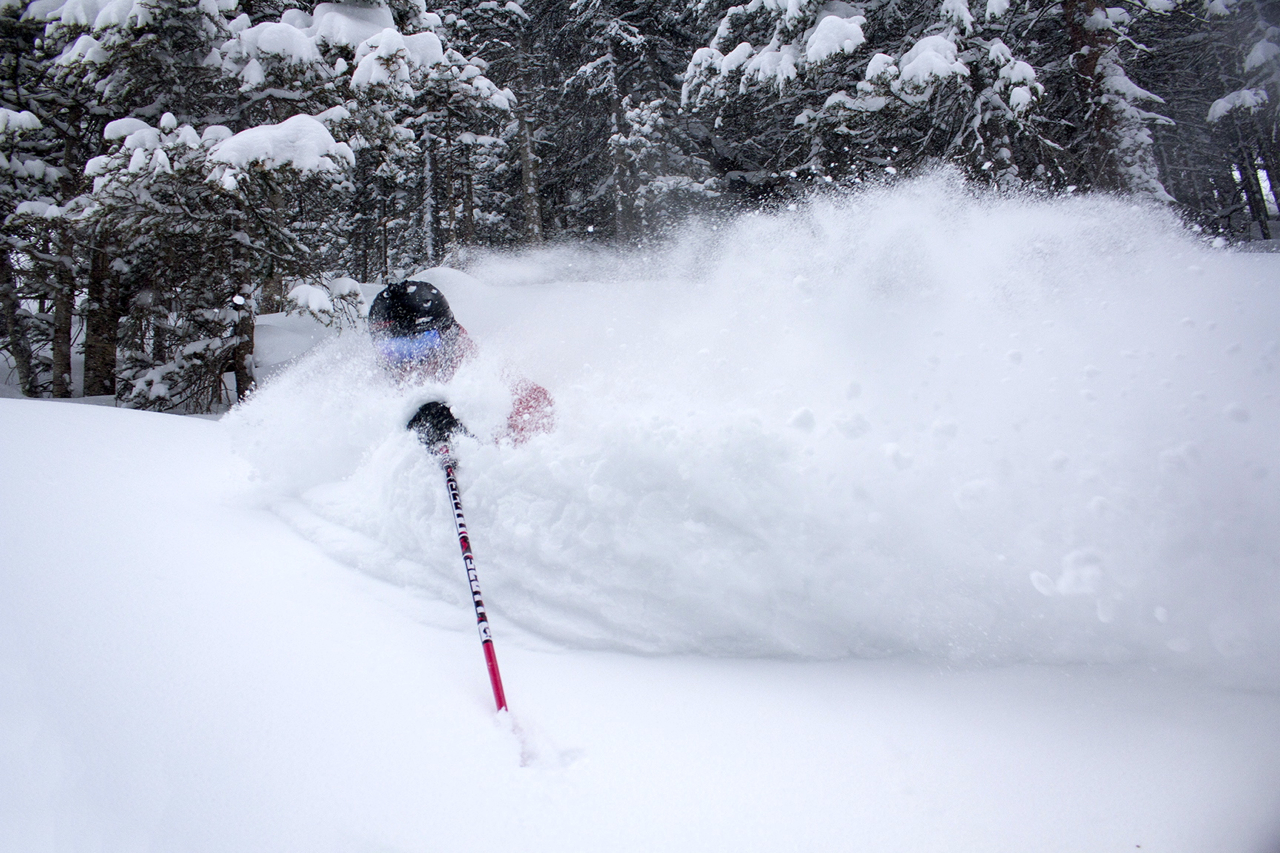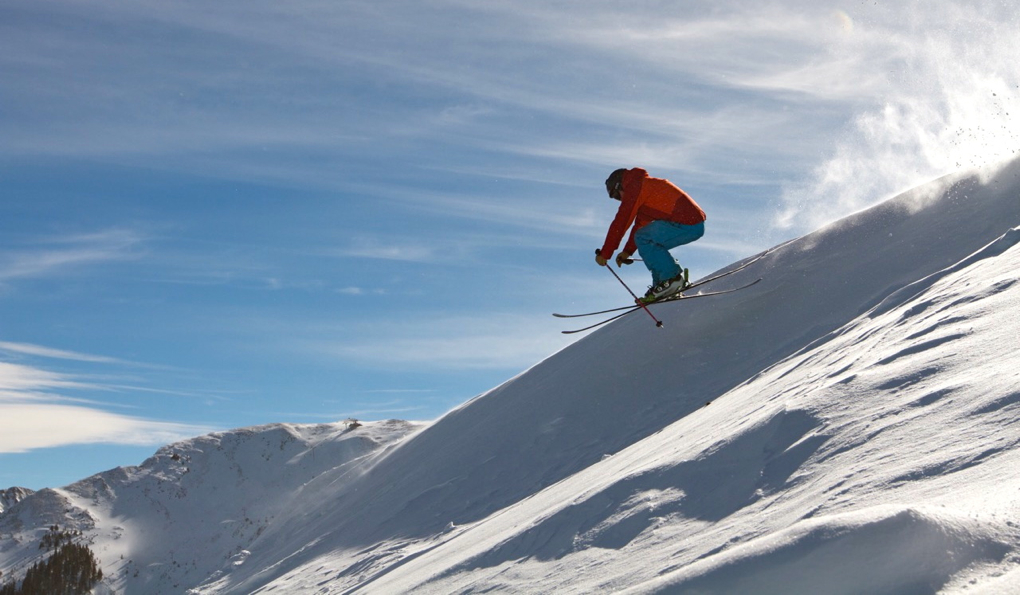
Jacket: Arc’teryx Lithic Comp
Size Tested: Large
Front Zipper Length: ~80.5cm
Blister’s Measured Weight (size L): 540 grams
Fit: “Expedition” Fit
Materials:
• N70p 3L GORE Fabric Technology
• Keprotec™
• Cordura® Nylon
• Trusaro™—60% nylon, 30% polyester, 10% elastane. Bonded stretch woven face fabric provides rugged weather shedding outer shell, while a smooth polyester knit lining allows for next to skin comfort and easy layering
Features:
- Taped seams
- Composite Construction (soft shell / hard shell)
- Articulated elbows
- Gusseted underarms
- Helmet compatible StormHood™
- Full front zip with laminated wind flap and chinguard
- WaterTight™ full length front zip
- Two hand pockets with WaterTight™ zippers (Note: WaterTight™ zippers are highly water resistant, but not waterproof)
- Two internal mesh pockets
- Hidden Recco® reflector
MSRP: $450
Reviewer: 5’10”, ~175 lbs.
Test Locations: Northern New Mexico backcountry; Taos Ski Valley
Days Tested: ~50
(1) The Lithic Comp is a very good jacket.
(2) Arc’teryx’s own description of it is also very good, and one of the most thorough, specific, and on-point product descriptions that I have come across. Kudos to them for that.
(3) Arc’teryx goes out of their way to make clear that the Lithic Comp jacket was designed specifically for backcountry touring. But in addition to touring, I’ve worn the jacket for more than 40 days of lift-served skiing, and for the right person, I could see this serving as both their resort and their backcountry jacket. I’ll say more about that below.

Here’s how Arc’teryx describes the jacket:
“Using Arc’teryx Composite Mapping technology to merge windproof, breathable GORE Fabric Technology with Arc’teryx Trusaro™ softshell, Arc’teryx created the Lithic Comp to manage the shifting physical output levels of backcountry skiing and snowboarding while delivering protection from varying alpine weather conditions.”
So yep, the Lithic Comp is a soft shell / hard shell hybrid jacket. Recently, we discussed hybrid outerwear pieces, and raised the question of why there are not more of them on the market? Well, the Lithic Comp is a stellar example of a hybrid piece done well.
Continuing with Arc’teryx’s description:
“Windproof, breathable GORE® Fabric Technology provides zonal waterproof protection on the front, shoulders, top of the arms and hood [i.e., all of the darker red/orange fabric you see on the jacket], areas most exposed to the effects of precipitation and descent driven snow. Arc’teryx Trusaro™ softshell material is utilized on the back and under the arms [the lighter orange fabric on the jacket] where air permeability and stretch are required. The result is a fabric composite providing essential protection from moisture while delivering high levels of breathability and stretch.”

I have about 50 days in the Lithic Comp, and have worn it in rain, in heavy snow storms (graupel, light pow, very wet snow), and on a number of bluebird, very warm days. It’s handled the whole range very well, and the jacket has never wetted out.
On some of the big storm days we’ve had this season, I was curious to see if the Trusaro softshell panels of the jacket would wet out, but they haven’t.
In other words, I have a number of jackets made entirely of Gore Tex Pro and Polartec NeoShell, and for skiing around the (generally drier) climate of northern New Mexico, I don’t feel like I’m making any compromise in terms of weather protection when heading out for the day in the Lithic Comp.
(To be clear, I’m not arguing that the Lithic Comp provides a level of water resistance that is equal to that of a full Gore-Tex Pro or full NeoShell jacket. But I am saying is that in terms of my actual use over 50 days – in a drier climate – the practical difference in this respect has not proven to be significant – at all, actually, in my experience.)
Ok, more from Arc’teryx:
“The Lithic is specifically tuned to elevate backcountry performance. Easily accessible hand pockets utilize a mesh backing to increase airflow across the chest, providing additional ventilation on ascents. The protective Storm Hood™ is helmet compatible and easily adjusts for a secure fit with maximized visibility. Two internal mesh dump pockets hold gloves, skins, toque or water bottle. A drawcord at the hem seals out drafts.”
One of the biggest things you should be aware of about the Lithic Comp is that it doesn’t have pit zips.
For a touring jacket, that had me nervous. And frankly, given that we hike a lot at Taos, often in warm temps, and typically at an elevation between 10,000 – 12,000 feet, a normal inbounds day involves numerous high output hikes, I want pit zips on my resort jacket, too.
So in addition to being surprised by the weather protection that the Lithic Comp provides, I have been most surprised and impressed by the fact that I haven’t missed traditional pit zips. I can quickly and easily unzip the chest pockets on the Lithic to get good venting, even when wearing a backpack (the zips aren’t obstructed by the pack’s waist belt or sternum strap).
There have been very few days (actually, just one extremely warm day – temps were in the upper-50s F) where I found myself wearing the Lithic Comp and wishing it had pit zips. (And on that day, I should have just been hiking in a baselayer). That’s impressive to me.

The only caveat here is that this is not an ideal system if you tend to stuff your pockets full of smaller items, since to ventilate, the Lithic Comp’s pockets have to be open. You do, however, still have two interior mesh dump pockets, but they don’t zip shut.
I’ve spent plenty of time hiking around with my phone, some earbuds, a spare goggle lens, and an energy bar or two tucked into the open pockets, and have yet to have anything fall out. But if you’re a pocket-loader-upper, then the Arc’teryx Caden, FlyLow LabCoat 2.0, or Strafe Temerity (review to come) are probably better options.
If, however, you generally ski with a backpack or don’t stash much in your jacket, the Lithic could be a great option for you.
NEXT: Fit, Breathability, Durability, etc.

I’ve been using this jacket all season and I agree wholeheartedly about everything said in this review except the fact that the softshell fabric does not wet out. In nearly all conditions it works perfectly, but when skiing in wet snow/rain for more than a short period of time it does eventually wet out, and moisture does make it’s way through the material (as experienced by an afternoon taking laps on a long chair with good snow up above but rain by the time you got back to the chair). The amount of moisture was minimal though, nothing that an insulator with DWR (atom lt, nano air, etc.) couldn’t handle.
Point is, this jacket is not a rain jacket. It’s purpose made for the backcountry in the winter and it does that job without complaint. Just don’t expect the soft-shell to be waterproof, that would be silly.
Thanks for the good feedback, Mike. And you’re right: I’m definitely not trying to make the case for the Lithic Comp as a dedicated rain jacket (that would, indeed, be silly). But I can only report on my real-world experiences with the jacket, and in rain / sleet / lighter pow storms, any wetting out of the softshell areas was so minimal (if it happened at all), that I didn’t notice it at all after pretty full days of lift-accessed riding. (The touring I did in the jacket was under pretty clear skies.)
So it’s good to learn that you did notice some wet out – though minimal.
I’ve learned that for where I ski most often, I care far more about high breathability than absolute, 100% waterproofness. I’m certain that some others are in the same boat, and hopefully this review (and your feedback) will help people figure out what equipment will make the most sense for them.
Thanks again.